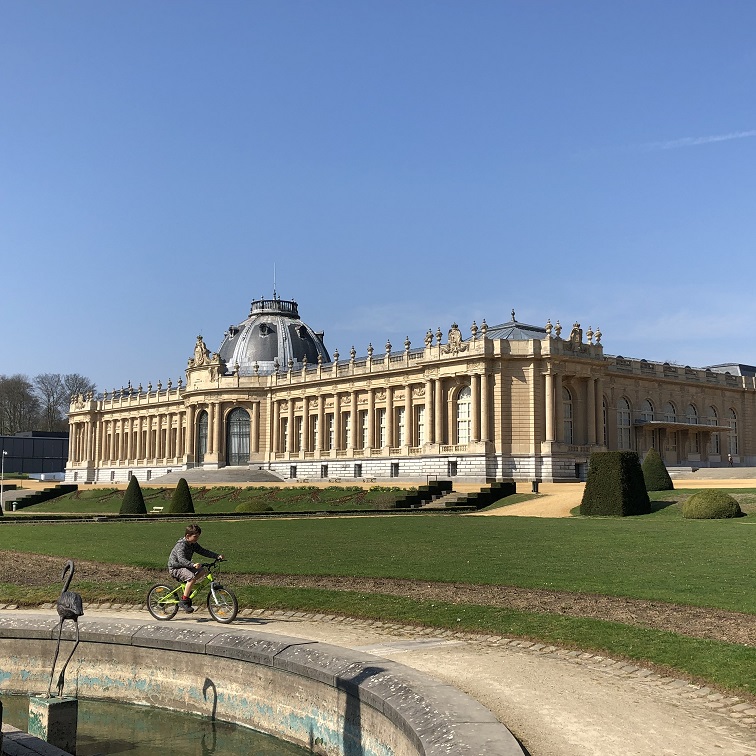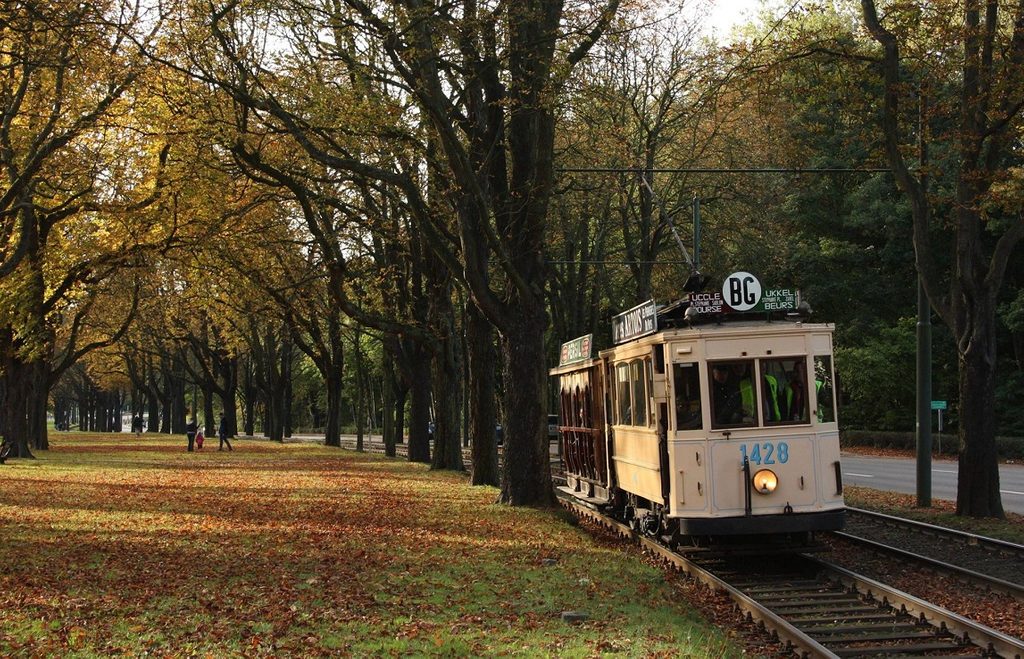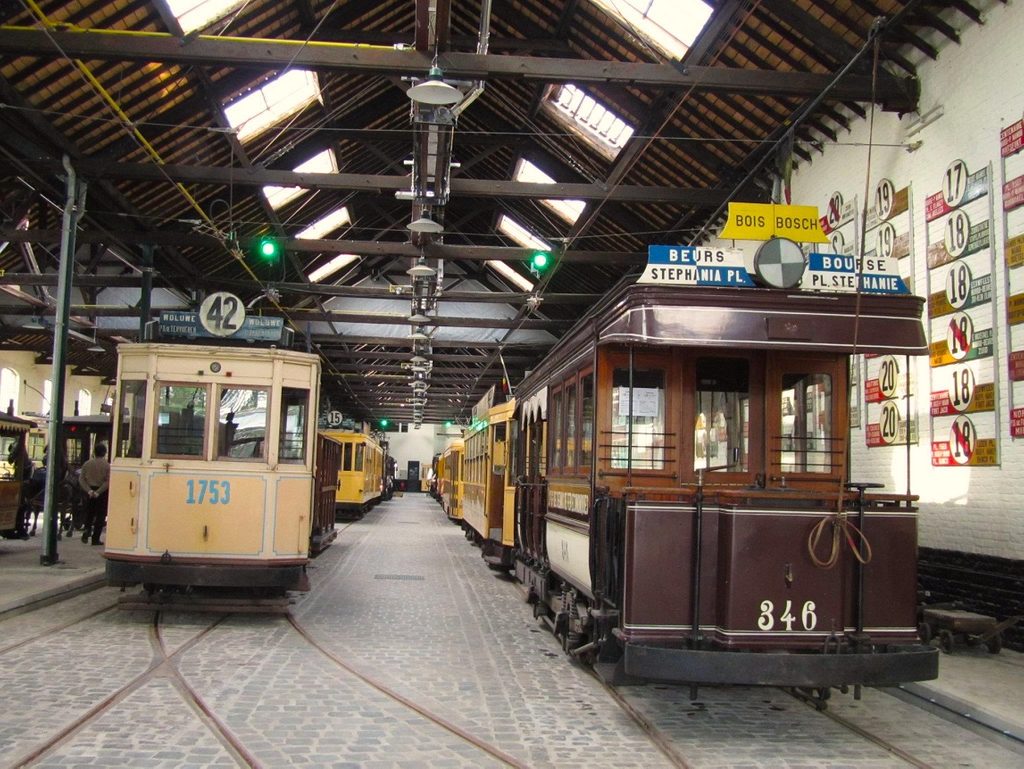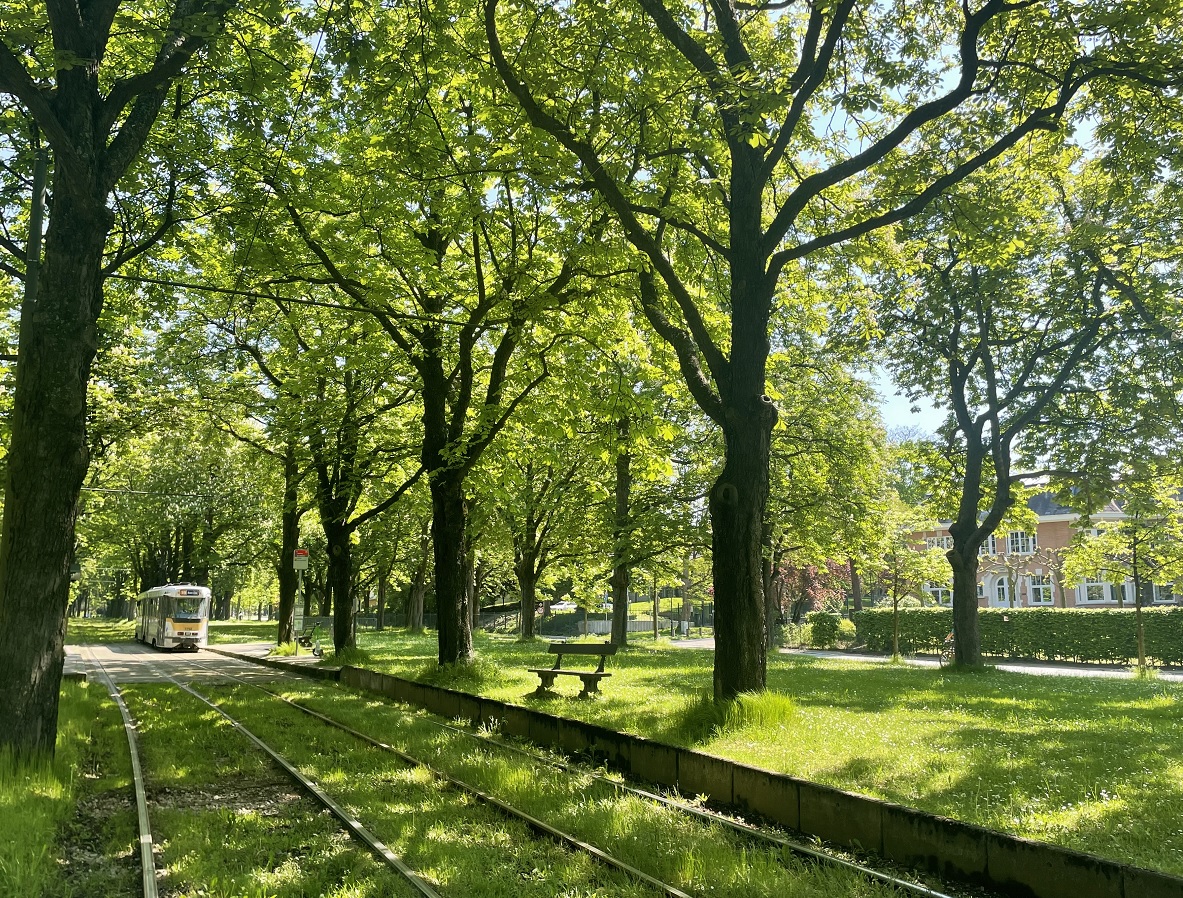Montgomery is a busy transport hub. On the surface there is the 81 tram and the 61 bus, just beneath that is the north-south Pre-Metro trams 7 and 25. And even more subterranean, the east-west Metro 1 plies the 12km from Gare de l’Ouest/Westastation to Stockel/Stokkel. Not to mention the roundabout with five arms and road tunnels, both north-south and east-west. All is sternly watched over at street level by a slightly bigger-than-life-sized statue of the eponymous Field Marshal.
Underground there is a modern station with a supermarket, a couple of coffee shops, a Di drugstore, an increasingly rare-as-hens’-teeth ATM, and a photo machine. The latter may prove useful if you are buying a season ticket at the archly named STIB Bootik where the service is both efficient and friendly.
If you walk past the two coffee shops away from the Bootik you will come across the original underground station. There the trams 39 and 44 await custom, having plunged into the Stygian gloom of a separate and more elderly tram stop. Being dimly lit and poorly decorated, it is not the most cheerful place to start two, great, indeed world-class, tram rides. But treats and some serious history await.
And if you wonder why the trams themselves seem almost as antiquarian as the station, the answer is simple: most modern trams are too long for two of them to berth there. So the city uses the so-called PCC trams. PCC stands for the somewhat pedestrian President’s Conference Committee and the trams were the last word in streetcar design in 1930s United States. Built in Belgium in the late 50s/early 60s, they were, intriguingly enough, cannibalised from trams first used in Nashville, Tennessee and Johnstown, Pennsylvania!
King’s avenue
Both trams follow the same track until they are about halfway up the Avenue de Tervuren/Tervurenlaan. This handsome boulevard was very much the brainchild of King Leopold II who sought to link the Cinquantenaire park with Tervuren village and the Museum of the Congo (now the Royal Museum for Central Africa).
As the Congo was, at that point in history, his personal fiefdom he was keen to tell its story – or at least part of it. He made strenuous efforts to hide the heart of darkness. The avenue, and its connecting road through the woods, were completed for the 1897 International Exhibition and His Majesty was no hands-off manager: design of streetlamps, concrete suppliers, bench styles - nothing escaped his eagle eye. “I would wish for more chestnut trees” he opined at one stage.

The Royal Museum for central Africa, Tervuren
If you want to see his original concept, look at Avenue de Tervuren as it runs down from Quatre Bras/Vier Armen to the museum. The tram tracks are to the left and a broad strip of grass suitable for horse riding runs dramatically down the middle.
By contrast, the part between Cinquantainaire and the forest has been forced to adapt to city traffic. Vestiges remain with Art Nouveau tram stops, fancy lamp posts, and a pathway in an avenue of trees down the middle.
The 1897 International Exhibition was quite a shindig, with 27 country pavilions, eight million visitors, and a reconstruction of Old Brussels which one scribe described breathlessly as a “precursor to Disneyland’s Main Street”. At Tervuren, they also built a reconstruction of an African village inhabited by the 270 Congolese forcibly shipped to Belgium. It was known at the time as a ‘human zoo’. It is perhaps worth recording that this unspeakable practice was common and the British, French, Dutch and Spanish all did likewise.
Shared space
The two trams first emerge into the sunlight just east of the Montgomery roundabout where undistinguished modern flats share space with impressive century-old villas (G.I. Martin). Almost immediately on the left, at number 190 is the old East German embassy, now a bank. Thankfully, the building has had its brutal three-metre-high fence torn down.
Both trams stop right opposite the stunning Stoclet Palace and just before the descent to Woluwe Boulevard (Leopold II). I have admired the palace for 50 years and am still awestruck by its slightly uncared-for beauty. Austrian architect Joseph Hoffman finished it in 1911 in the so-called Viennese Secessionist style, foreshadowing Art Deco.

The Palais de Stoclet
He was given total liberty of budget and aesthetic choices. He built what was known in German as a Gesamtkunstwerk, or “complete work of art”. Distinguished artists, among whom was Gustav Klimt no less, designed the interior. Everything is of a piece, including doorknobs and lamps. And it is said that the lady of the house had to wear dresses which were specially designed so as not to clash with the decor on important social occasions.
So far so good. However, I have never seen a chauffeured car sweep out, a curtain twitch or a high-end butcher with a basket of sausages walk round to the tradesman’s entrance. Nothing. The house is in the possession of the four grandchildren of banker Stoclet who wish neither to live there, nor to sell it, and do not permit the public to visit. Two caretakers maintain the building, but it is otherwise unoccupied. We are in Stephen King territory!
Which leaves the admirer to stare at this slightly streaked vision of forlorn loveliness and wish that one day it will be put to good use. Oh, and maybe to marvel at the modern office block to the right as it doffs its hat in, presumably expensive, deference to its classy neighbour.
Transport nerd Mecca
Woluwe Park, one of the largest in Brussels, is among several green spaces along the Woluwe valley (Jules César). It is to the right as the trams rattle down the hill. At the request of King Leopold II, the park was created for the Universal Exhibition of 1897 and to link the exhibition's two sites: Cinquantenaire and Tervuren. Indeed the 44 tramline was built especially for that purpose.
Designed by French landscape architect Emile Lainé, the hilly English-style park has long winding paths, copses, lawns, ponds and reedy wet meadows beloved by migratory birds. Through it passes the Delta to Tervuren cycle path. The bridge, allowing cyclists and walkers not to have to descend and cross the busy Tervuren Avenue, is both spectacular and practical. You can climb up to the bridge from street level and cycle, jog, or stroll through greenery for kilometres in either direction.

An old tram trundling up Avenue de Tervuren
Under the bridge on the left is the Brussels Tram Museum (Musée du Tram/Trammuseum). The tram depot houses a collection of elderly trams, buses and taxis, some of which are available for private events. From April to September, the doors are open every weekend and on public holidays from 1pm to 6.30pm On opening days, very old trams run from the museum to Tervuren, some dating back a century-and-a-half. Classic buses also ply the route from the museum to the European Quarter.
The museum is staffed entirely by volunteers, and it shows - in a good way. In a 10-minute conversation I learnt, inter alia, that trams were very expensive when they started in Brussels, with a ticket costing one-tenth of a labourer’s daily hire. Thus, initially trams terminated where the wealthy went before they got cars: Tervuren park, the Cambre woods, the race tracks at Boitsfort/Bosvoorde and Sterrebeek (early Brussels tram joke: the rich rode out to the track on the tram but if they betted poorly they had to walk back!).
They also revealed that trams used wooden poles to carry the power cables to the overhead wires; it was the conductor’s job to grab a pole and reattach it when contact was lost, which was frequent. This became impractical when trams went underground, so the trams were retrofitted with ‘jointed pantographs’ now seen on all trains and trams.
The museum is old-fashioned in that there is little interaction with the exhibits. The driver’s seats, which are exactly where young children would love to play, are chained off. Indeed, one official tells me “This is a museum, not a fun park.” That said, for the public transport nerd, the moderately curious, and the well-behaved child it is a fine place to spend an hour on a wet Sunday!

The old carriages in the Tram Museum
Just past the Tram Museum there is, as the tram heads up the bosky hill towards Orban, the most superb villa from, I guess, the 1950s (De Villalobar). It looks over the parkland to the east of Souverain, is designed to nestle comfortably into the bottom of the hill, has no fences, guards, gates, high hedges or other paraphernalia of the uber-wealthy, and just stands there snugly exuding elegance for all to see. Gorgeous!
The 39’s swing to Stockel
As the 39 swings left up Orban and on the right in an otherwise suburban street is the extensive estate of Les Fraternités du Bon Pasteur (Madoux). Little can be seen from the tram beyond a thick hedge and a small shrine. Within is a handsome chateau and a religious community of some 70 people. All is entirely hidden from the surrounding flats and houses.
If you are determined enough you can go round the back of the estate, on Rue au Bois/Bostreaat, just near the ICHEC Brussels management school, seek out a little lane beside it signposted Fraternités du Bon Pasteur, follow the lane down, and end up in a vast, hidden away, green area. And maybe, just maybe, you can talk to one of the volunteers who work there about their various projects, agricultural and charitable.
The 39 arrives at Place Dumon/Dumonplein which is a major social centre. Its market, predominantly for food, drink and flowers, takes place every Tuesday, Friday and Saturday (Stockel/ Stokkel). Vibrant and fun, it is, of course, better to take the tram there, as parking is not easy on market days. At the time of writing, there is a funfair in the square, with shooting galleries, carousels, swings, toffee apples, candy floss and, of course, the ubiquitous frituur on hand. For those who seek quieter or more sophisticated pleasures, there are elegant shops and fine eateries nearby.
Also close by, and a real Brussels treasure, is an example of that most endangered of species: the suburban cinema. Le Stockel has been recently refurbished and now elegantly recalls a cinematic heyday when locals would walk to the local flea pit on a Saturday night. The film choices are eclectic but not overly arty, and they will show several different films on their single screen on the same day.
The remainder of the 39 route is a bizarre joy. It picks up the railway-turned-cycle-and-jogging path from Delta, still referred to as the ‘chemin de fer’, and then insouciantly sweeps through the bucolic outer suburbs, past embankments densely rewilded way before anyone knew what the word meant. From there, it crosses fields nervously awaiting brutal urbanisation, through verdant, unmanned stations loud with birdsong and redolent of Adlestrop, (Bel Air) and over the only tram bridge spanning the Brussels ring road, until it finally and abruptly comes to rest in the middle of a Flanders field for no apparent reason (Ban Eik).

Bel Air, the 39 terminus
Except, of course, there was (a reason). Back in the day when tram rides were within the reach of the well-off only, the final stop was a short stroll to the Sterrebeek racetrack. A Day at the Races, indeed. The track is now closed and being converted into flats, office space and a golf course.
Tervuren, through the trees
While the 39 scoots off towards Stockel, the 44 continues up the hill towards the Sonian Forest/ Forêt de Soignes/Zoniënwoud. Suddenly, a mere 10 kilometres from the mediaeval heart of Brussels, the tram is rattling through what could be, to the inexpert eye, the Russian taiga.
At this time of year particularly the leaves are a fresh, translucent, shimmering green, wildflowers spring up on the forest floor, and ferns are suddenly everywhere (by autumn, the scene is a blaze of russet colours). Trams, being noisy, do not encourage the roe deer, or the foxes, or the squirrels to make their presence felt. But they are there.
The tram emerges at (Quatre Bras/Vier Armen) a confluence of motorway tunnels, tram stops, roads through the woods, and the beginning of the handsome continuation of the avenue down to Tervuren village. This Quatre Bras is not to be confused with the Battle of Quatre Bras, a precursor to Waterloo, where Wellington fought Marshal Ney. That was slugged out south of Nivelles. French history books record it as a French victory and British as British. Take your choice!
The 44 comes to rest at a rather unique circular tram stop opposite the Royal Museum for Central Africa (Tervuren Station). A major effort by Leopold II to justify Belgium’s colonial efforts in the Congo, this magnificently housed museum, itself overlooking a glorious park, was and to some extent remains, deeply controversial.
For some time, Congo was run cruelly and for profit for the king. Keen to distance itself from his brutality, the museum underwent a five-year refurbishment museum, reopening in 2018 after it had excised elements lionising colonialism. The museum also now has a section dedicated entirely to the subject of racism and presents itself as a space where the academic and the curious can study and learn in an atmosphere of honest inquiry.
Belgium is now a decent and tolerant place. Its effort to face up to its own, or perhaps the king’s, shameful past is surely to be applauded. And that certainly makes the museum – now also known as AfricaMuseum – a fascinating visit.
Have they got the balance right? Should more be done? Less? It seems almost frivolous to vaunt the beauties of the tram ride built specifically to propagandise rapacious colonialism. Or indeed to stroll around the park lakes where six Congolese canoeists, exhibiting in the 1897 exhibition, drowned in the frigid water.
To add insult to injury, for decades they were denied a decent burial by the authorities – their graves tended only by good-hearted locals. We cannot change the past: we can remember it with integrity. Which is exactly what the museum is trying to do.
And surely due acknowledgement of Congo’s dark history renders the spectacular beauties of the 44 tram ride all the more poignant.

